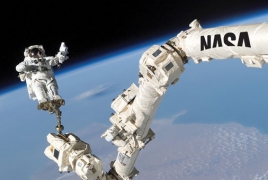
In the first public inkling of the Trump administration’s aspirations for space exploration, NASA announced on Wednesday, February 16 that it wanted to consider taking astronauts on the first flight of its new heavy-lift rocket. That type of notable mission could speed up a return to the moon, The New York Times reports.
Robert M. Lightfoot Jr., the acting NASA administrator, said the agency was studying what it would take to add a crew to the first flight of the Space Launch System, a mammoth rocket under development for deep space missions.
Under current plans, the first launch was scheduled for late 2018 and did not include a crew for testing the systems aboard the rocket and the capsule, named Orion.
That would have been followed by a gap of several years before a second flight, with astronauts, that would have taken off no earlier than 2021.
Mr. Lightfoot spoke at a conference for companies working on the Space Launch System and Orion programs. Boeing is the main contractor for the rocket; Lockheed Martin is building Orion. Mr. Lightfoot also sent a memo to NASA employees.
“I know the challenges associated with such a proposition, like reviewing the technical feasibility, additional resources needed, and clearly the extra work would require a different launch date,” Mr. Lightfoot wrote in the memo. “That said, I also want to hear about the opportunities it could present to accelerate the effort of the first crewed flight and what it would take to accomplish that first step of pushing humans farther into space.”
Under the current plans for the first launch, a crewless Orion capsule would spend three weeks in space, flying to the moon and entering an orbit about 40,000 miles above the surface. With astronauts on board, the mission would most likely be shorter, perhaps similar to the trajectory taken by Apollo 8 in December 1968, when three NASA astronauts made 10 orbits around the moon in 20 hours and then returned to Earth.
To add astronauts would require significant work and rejiggering. Because no astronauts were planned, the Orion capsule planned for the first flight currently did not contain the full working life-support system. The first Space Launch System rocket also uses an upper stage that is derived from the Delta 4 rocket that has not been rated for crewed missions. NASA is developing a more powerful upper stage for the second flight.
The risks of flying people on the first launch of a rocket are much greater. In the Apollo program, NASA launched several crewless missions to gain confidence before adding astronauts on Apollo 7. Two commercial systems by Boeing and SpaceX to take astronauts to the International Space Station will also fly crewless test flights first. The first launch of the space shuttle in 1981 did carry astronauts.
Boeing and Lockheed Martin put out statements that supported the effort. “The possibility of NASA accelerating the timeline to put humans into the vicinity of the moon and onto Mars is exciting,” Boeing said.
The Lockheed Martin statement noted some of the challenges. “We’ll look at accelerating remaining crew system designs, as well as potential technical and schedule challenges and how to mitigate them,” the company said.
Trump administration officials have not provided much information about their plans for NASA, and no permanent administrator has yet been nominated.
During his inaugural speech, President Trump made a passing mention of a desire “to unlock the mysteries of space.”
Mr. Lightfoot wrote in his memo, “From my interactions with the transition team, NASA is clearly a priority for the president and his administration.”

